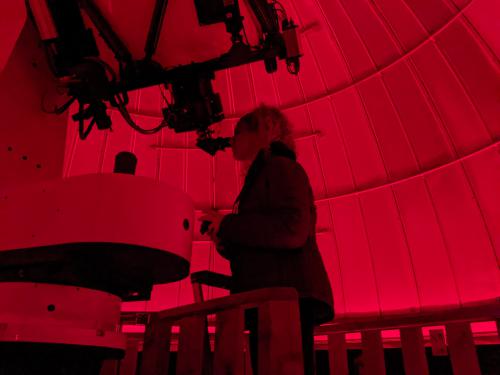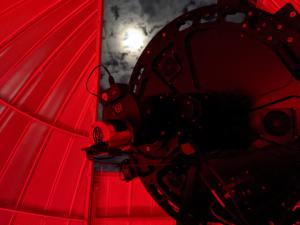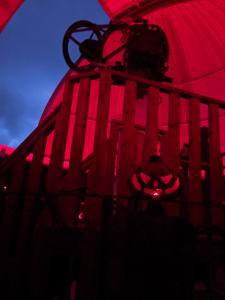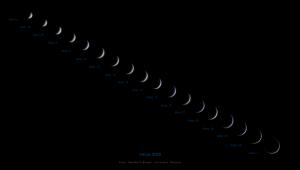Celebration of Space - October 21, 2022
On October 23, 2022, the Frosty Drew Observatory will celebrate the first anniversary of our new PlaneWave CDK600 telescope in the Observatory dome. Over the past year we have been busy calibrating and optimizing the new device, which became fully operational at the end of February 2022. Since then, the views and images have been breathtaking! We have so many ideas and plans for the new telescope, and after one year, we are still at the height of our excitement for the new telescope.
The PlaneWave CDK600 is a 24 inch Corrected Dall-Kirkham telescope. The telescope was built in Michigan, US, specifically for the Frosty Drew Observatory. Previously, the Frosty Drew Observatory housed a Meade LX200 EMC 16 inch Schmidt Cassegrain telescope, which served as our primary telescope for over 21 years. During the early 2010’s the Meade telescope started to fall short of our goals and demands. We had retrofitted the device several times throughout the following decade with custom upgrades and repairs, though we became quite fearful that the telescope, in its form at the time, was facing imminent failure. But it is unfair to say that the Meade was a problematic telescope.
Each telescope we have has a Life List, which is a list of objects that the specific telescope has observed. Our Meade LX200 has a life list of nearly 1,000 objects that it has shown to our visitors! On this list are some very notable objects, like CTA-102, which is a quasar that had an outburst in 2016. CTA-102 is over 5 billion light years distant! The telescope’s list also includes many comets and a few near-Earth asteroids. Take a moment to review the life list of our old Meade LX200. After a year off, we will be moving our Meade LX200 EMC 16 inch back into service as a Courtyard telescope. We have retrofitted the old telescope tube to a modern Losmandy mount, and will be unveiling the upgrade later this year.
As for the new PlaneWave CDK600 telescope, we have reconvened our imaging projects in the Observatory, after years of being on pause. The capabilities of the CDK600 are phenomenal and make our jobs so much easier. The CDK600 mount (L-600) utilizes direct-drives in each motion axis, instead of gears. A feature that solves many of the regular issues that astronomers have to deal with when performing imaging projects. It also makes the telescope much more visitor friendly when opening on public viewing nights since it is not so fragile in regards to visitors touching the telescope. Over the past 8 months we have been capturing images of several deep sky objects, mostly galaxies. Here is a gallery of images captured by the new CDK600 telescope. Additionally, the CDK600 has begun cataloging its own life list, which currently has over 100 objects on it, and is visible.
If you haven’t stopped in to check out the new telescope yet, then you are very overdue a visit! Be sure to add Frosty Drew Fridays to your calendar and swing by for a moment with the new telescope, and experience the cosmos in a whole new light. Take a moment to check our timelapse of the entire upgrade and installation process.
Next Friday, October 28, 2022, the Frosty Drew Observatory and Science Center will host our annual Spooky Views – A Halloween Stargazing Experience. Over the years this event has grown from a few decorations in the Observatory into a fabulous night of creepy tales, displays, presentations, activities, candy, and of course - stunning telescopic views. Starting at 6:00 pm the Frosty Drew campus will be buzzing with Halloween creep. At 6:30 pm and again at 8:15 pm, sit with our Sky Evangelists under the willow for a family friendly story time. At 7:00 pm, and again at 8:45 pm, the Sky Theatre will host the original 1938 War of the Worlds radio broadcast, by Orson Wells, accompanied with select images shown on screen. A scavenger hunt will be available for kids (and adults), designed to take you around the campus. In our telescopes we will be observing a host of stars that have died and are going through their death process by casting off their outer shells as a nebula. We will also have views of Saturn and Jupiter. Of course, there will be candy for all who attend. So make plans to visit next Friday, either in costume, or just as your fabulous self, and kick off your creepy Halloween weekend with a spooky view. Tickets are required, and will go on sale today. You can get tickets and learn more about the event on our website.
Tomorrow, Saturday, October 22, 2022, Venus will arrive at the point in its orbit where it is on the opposite side of the Sun than Earth. We call this Superior Conjunction, and will bring Venus’ full phase. Venus, which takes on the role of either the Morning Star or the Evening Star, has an orbital period of 225 Earth days. Depending on Venus’ location around the Sun, will determine if Venus is visible in the morning sky or evening sky. Though one thing is certain, Venus will never be high above the south sky during the middle of the night. This is because Venus is closer to the Sun than Earth, and consequently, we have to look towards the Sun to see Venus. When Venus is on the west side of the Sun, we have a chance to see Venus in the evening sky, and when Venus is on the east side of the Sun, we have a chance to see Venus in the morning sky. But when Venus is at superior conjunction, or inferior conjunction (when Venus passes in between Earth and the Sun), we miss out on a view due to the Sun interfering. Since Venus orbits the Sun in a prograde manner (counter-clockwise), the planet will progress in its orbit towards the western side of the Sun, and we will start to see Venus in the evening sky over the next couple of months. Once Venus becomes reasonably visible in the evening, we will frequently post about viewing opportunities.
- Author:
- Scott MacNeill
- Entry Date:
- Oct 21, 2022
- Published Under:
- Scott MacNeill's Columns






